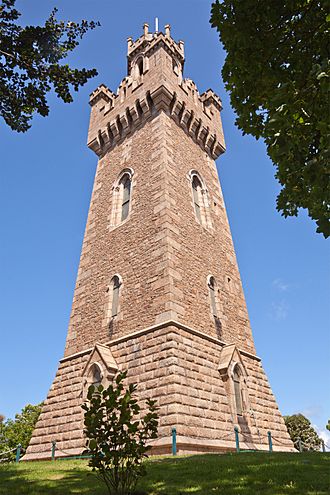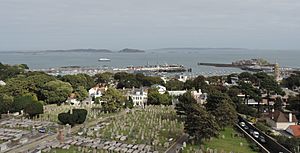Victoria Tower, Guernsey facts for kids
Quick facts for kids Victoria Tower |
|
|---|---|

Victoria Tower in Guernsey
|
|
| General information | |
| Type | Tower |
| Location | St Peter Port, Guernsey, Channel Islands |
| Construction started | 1848 |
| Cost | £2000 (in 1846) |
| Design and construction | |
| Architect | William Colling |
Victoria Tower is a special monument found in Saint Peter Port, Guernsey. It was built to celebrate a very important visit. In 1846, Queen Victoria and Prince Albert came to the island. This tower helps everyone remember that historic day.
Contents
The Story of Victoria Tower
Why Was the Tower Built?
The visit by Queen Victoria in 1846 was a huge event. It was the first time a ruling king or queen had ever visited Guernsey! To mark this special occasion, a small granite stone was placed where the Queen first stepped ashore in St Peter Port harbour.
The very next year, an architect named William Colling was asked to design a tower. This tower would be a lasting memory of the Queen's visit.
Building the Tower
The perfect spot for Victoria Tower was chosen. It was on a small hill across from the Arsenal. The Arsenal was where Guernsey's local army, called the militia, kept their weapons.
On May 27, 1848, the first stone of the tower was laid. This was done in a big ceremony by the Governor of Guernsey, Major General John Bell. Inside the tower's foundations, a special "time capsule" was placed. It held coins from both Guernsey and England.
Royal Visits to the Tower
Years later, on August 14, 1859, Queen Victoria and Prince Albert visited Guernsey again. After touring the island, they came to see the tower that was built in their honour.
Reopening the Tower
In 1999, the tower had some problems and had to close to visitors. But after repairs, it reopened on May 24, 2006. This date was Queen Victoria's birthday! The reopening was a special event, just like when the first stone was laid. The Lieutenant Governor of Guernsey, Vice Admiral Sir Fabian Malbon, reopened the tower. The Bailiff Geoffrey Rowland was also there.
What's Around the Tower?
The Arsenal and Fire Station
Right next to Victoria Tower is the Town Arsenal. This building was originally used to store big guns for the Royal Guernsey Militia. Today, it's used by the Guernsey Fire and Rescue Service.
The Public Garden and Cannons
A public garden was created around the tower. At first, it had two cannons that were captured from the Russians during the Crimean War. These cannons are now on display at Castle Cornet.
Later, other guns were placed in the garden. These included four large German guns from 1909. Two of these were removed in 1938. The remaining two were actually buried in 1940. This was done as World War II started. The idea was to make invading German forces think the island wasn't well-protected.
In 1978, the two buried German guns were dug up. Now, you can see them back on display in the garden around Victoria Tower.


